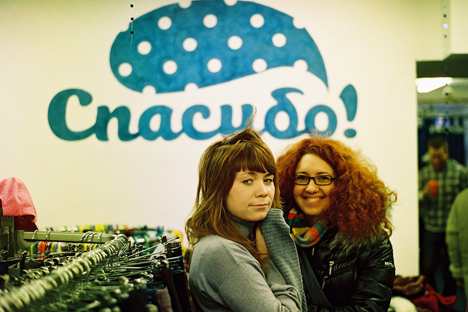Charity shops in Russia: Teaching people to give, one item at a time

Da Ra Shop in Yekaterinburg. Source: Press Photo
When Valery Koverchik decided to open Yekaterinburg’s first charity shop about 18 months ago, he spent all the money he had saved to buy a car redecorating and outfitting the small storefront he found.
“I went to my day job at 7 or 8 a.m. in order to finish by lunchtime and go to my shop. I got home about 10 p.m. I lived like that for several months,” Koverchik said.
Related:
Siberian children’s fund launches online charity network
Russia’s biggest charity raises over $600,000 at a New Year’s event in London
Finally the day of the grand opening arrived. The bare concrete walls lit only by a single light bulb had been transformed. Inside the store, which Koverchik named the Da Ra Shop, clothes hung neatly on racks and tea and cookies were prepared for the guests. But no one showed up. Not a single person Koverchik had invited either personally or through social networks showed any interest.
“The word ‘charity’ scares away many Russians. When people hear it, they think: ‘Now they are going to ask for something,’” Koverchik said.
But Koverchik persevered and today the shop has more than 1,500 fans on social networks who support its work by visiting the store or ordering goods online. Although the profits are modest, the store is no longer in the red. Koverchik donates the money that remains after paying rent and utilities to a local animal shelter.
All of Russia’s 17 thrift stores are private initiatives, typically run by energetic young people looking to better the world around them. The stores do not benefit from preferential tax legislation and often have to structure their operations in ways that adhere to the letter of the law, rather than the spirit of thier initiatives.
According to Polina Filippova, the director of the Russian branch of the UK-based Charities Aid Foundation, “The problem is that the attitude to the idea of charity in Russian society leaves a lot to be desired.” For the majority of Russians, charity means giving alms to a beggar in the subway while they are suspicious of organizations working in this sphere.
“And non-profit organizations are under tough government control,” Filippova added.
Second-hand capital
Moscow’s Lavka Radostei (Joy Shop) doesn’t officially sell goods at all; rather, it exchanges them for donations. This is one of the conditions of the shop’s existence since legally it is a charity. Visitors to the shop select items and then suggest the price they are willing to pay.
Lavka Radostei in Moscow. Source: Vadim Kantor / Moskovskie novosti
Owner Yekaterina Bermant has been surprised at the amount and quality of donations that make their way to the shop. Lavka Radostei’s donors are typically members of Moscow’s upwardly mobile middle class who bring in name-brand goods. Bermant along with sales attendant Maria Timofeyeva make sure that valuable designer items don’t go for too little.
“I recommend that people think of the price of a similar item new and then give 20-40 percent of the cost for the second-hand piece,” Timofeyeva said.
Lavka Radostei takes in about $8,000 a month. The money is then transferred to Vse Vmeste (All Together), a non-profit umbrella group for Moscow’s grassroots charity and volunteer organizations. Vse Vmeste’s operating council then distributes the money among 30 funds, including those working with low-income families, orphans and people with disabilities.
“We want to clothe the whole city”
Russia’s first charity shop, Spasibo (Thank You), opened three years ago, in St. Petersburg. The store was the brainchild of Yulia Titova, who got the idea after a visit to the UK, where charity shops are common.
Spasibo charity shop in St. Petersburg. Source: PressPhoto
“My friends and I were fresh out of university and were full of ideas: ‘Charity shops! Great! They make for a better world!’ Titova said. “But we had no idea of the legal niceties. It was only three months after we opened Spasibo that we realized we had to pay taxes.”
Today Spasibo has expanded into two shops and a distribution center. The shops have also become a venue for master classes, exhibitions, concerts and book exchanges.
In the average month, Titova’s team receives between four and eight tons of dresses, jackets, footwear, books and toys. Only about 10 percent of these items end up being resold. The rest are given away for free. Those in need can visit the shop to select items three times a week. The slogan on Spasibo’s social network page reads: “We want to clothe the whole city.”
Titova now dreams of quadrupling the net profit from the two shops to $12,000 a month. Her other dream is to gradually educate people in Russia that their old clothes can be used again and again. She believes that people aren’t opposed to the idea of charity; they are just unaware of the many ways they can contribute to helping others.
“Russians are prepared to do good; they are no different in that way from other people,” said CAF’s Filippova. Although increasing the number of charity shops from zero to 17 in three years is a significant accomplishment, much remains to be done.
In the meantime, the CAF 2012 World Giving Index, which ranks countries according to the percentage of people who donate money to charity, volunteer their time, and help a stranger, rated Russia 127 out of 160 countries worldwide. This was already a bump up for Russia, however. The country was ranked 138th in 2011.
All rights reserved by Rossiyskaya Gazeta.
Subscribe
to our newsletter!
Get the week's best stories straight to your inbox
